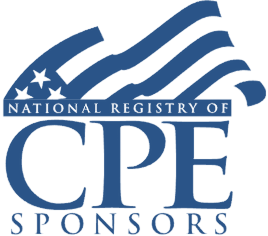Welcome! Save 30% on all CLE, CPE, and Professional Skills webinars, plus 15% off any annual pass with code HOLIDAY25
About the Course
Introduction
This webinar will walk trust and estate advisers through the process of identifying and categorizing trusts by analyzing key provisions in trust documents. Our panel of trust experts will provide examples illustrating the taxation and reporting responsibilities of specific trusts based on their classifications.
Description
Identifying a specific trust by type is critical in order to report, administer, and tax the trust and its beneficiaries properly. All trusts have common attributes. Each has a grantor, a trustee, and beneficiaries. The taxation of and reporting responsibilities vary significantly depending on how a trust is structured. Irrevocable trusts generally have their own EIN (employer identification number) and file and report their income and deductions on Form 1041, U.S. Income Tax Return for Estates and Trusts. They might, however, be a grantor or non-grantor trust. If a grantor trust, the grantor reports the trust income and deductions on the personal income tax return.
Trusts have the steepest graduated tax table reaching a maximum tax rate of 37 percent at only $15,650 (2024). This low threshold makes it crucial that trust advisers understand the tax attributes of a particular trust. Specific provisions in a trust document are key to identifying a trust's classification and ultimate tax consequences. Trust advisers must be able to recognize and interpret these relative provisions.
Listen as our panel of top-level trust advisers demonstrates how to identify specific trusts and their relative tax consequences.
Presented By

Ms. Weisgerber practices in the areas of estate planning, elder Law, probate law, family law, real estate, business law and tax controversies.

Mr. Woodwell attended New England Law | Boston and graduated in 2016. Following New England Law he received his LLM in Taxation with a focus on Estate Planning at Boston University's Law School. Before joining the firm Mr. Woodwell worked extensively in probate across the entire Commonwealth of Massachusetts, specifically focusing on conservatorship, guardianships, estates and the MassHealth application process for long term care.
-
BARBRI is a NASBA CPE sponsor and this 110-minute webinar is accredited for 2.0 CPE credits.
-
BARBRI is an IRS-approved continuing education provider offering certified courses for Enrolled Agents (EA) and Tax Return Preparers (RTRP).
Date + Time
- event
Wednesday, April 30, 2025
- schedule
1:00 p.m. ET./10:00 a.m. PT
- Identifying trusts and their tax consequences: Introduction
- Grantor trusts
- Intentionally defective grantor trust (IDGF)
- Qualified Subchapter S trust (QSST)
- Grantor retained annuity trust (GRAT)
- Non-grantor trusts
- Simple
- Complex
- Revocable
- Nonrevocable
- Irrevocable life insurance trust (ILIT)
- Spousal lifetime access trust (SLAT)
- Trust income tax rates
- Examples
The panel will review these and other critical issues:
- Reporting requirements for grantor trusts
- Identifying irrevocable trusts from language in the trust document
- Distribution requirements for simple and complex trusts
- Illustrative examples including trust documents and tax scenarios for specific trust types
Learning Objectives
After completing this course, you will be able to:
- Identify simple trusts from language in a trust document
- Determine why and how some grantor trusts are intentionally defective
- Decide how to minimize tax on trusts and trust distributions
- Ascertain key tax reporting differences of grantor and non-grantor trusts
- Field of Study: Taxes
- Level of Knowledge: Intermediate
- Advance Preparation: None
- Teaching Method: Seminar/Lecture
- Delivery Method: Group-Internet (via computer)
- Attendance Monitoring Method: Attendance is monitored electronically via a participant's PIN and through a series of attendance verification prompts displayed throughout the program
- Prerequisite: Three years+ business or public firm experience preparing complex tax forms and schedules, supervising other preparers or accountants. Specific knowledge and understanding of estate, gift and trust taxation including various trusts types, the unified credit, and portability.

BARBRI, Inc. is registered with the National Association of State Boards of Accountancy (NASBA) as a sponsor of continuing professional education on the National Registry of CPE Sponsors. State boards of Accountancy have final authority on the acceptance of individual courses for CPE Credits. Complaints regarding registered sponsons may be submitted to NASBA through its website: www.nasbaregistry.org.

BARBRI is an IRS-approved continuing education provider offering certified courses for Enrolled Agents (EA) and Tax Return Preparers (RTRP).

BARBRI CE webinars-powered by Barbri-are backed by our 100% unconditional money-back guarantee: If you are not satisfied with any of our products, simply let us know and get a full refund. Contact us at 1-800-926-7926 .
Unlimited access to premium CLE courses:
- Annual access
- Available live and on-demand
- Best for attorneys and legal professionals
Unlimited access to premium CPE courses.:
- Annual access
- Available live and on-demand
- Best for CPAs and tax professionals
Unlimited access to premium CLE, CPE, Professional Skills and Practice-Ready courses.:
- Annual access
- Available live and on-demand
- Best for legal, accounting, and tax professionals
Unlimited access to Professional Skills and Practice-Ready courses:
- Annual access
- Available on-demand
- Best for new attorneys
Related Courses

Partnership Terminations: Sale or Abandonment of an Interest, Retirement or Death of Partner, and Closing the Entity
Wednesday, February 18, 2026
1:00 p.m. ET./10:00 a.m. PT

UK-Based Retirement Accounts for U.S. Taxpayers: Mastering Reporting, Maximizing Planning Opportunities
Tuesday, January 27, 2026
1:00 p.m. ET./10:00 a.m. PT

Tax Research Techniques: Internet Tools, AI Caveats, Methodology, Documentation and Communication of Results
Wednesday, January 21, 2026
1:00 p.m. ET./10:00 a.m. PT

The Impact of OBBBA on Trusts and Estates: New Planning Opportunities
Monday, January 26, 2026
1:00 p.m. ET./10:00 a.m. PT
Recommended Resources

How CPE Can Bridge the Gap Between What You Know and What You Need to Know
- Career Advancement


